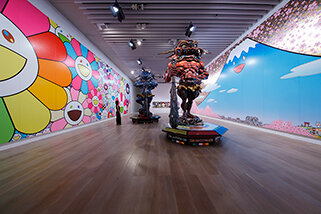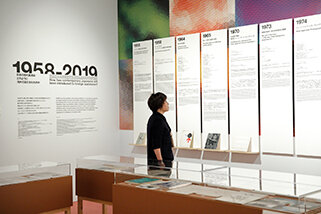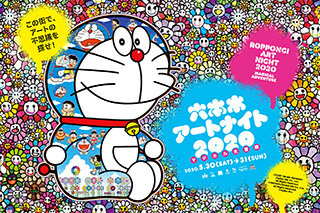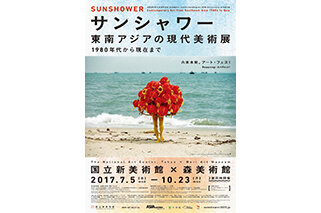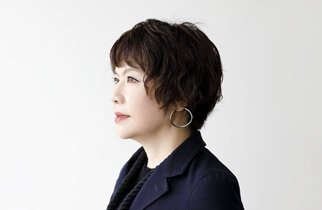
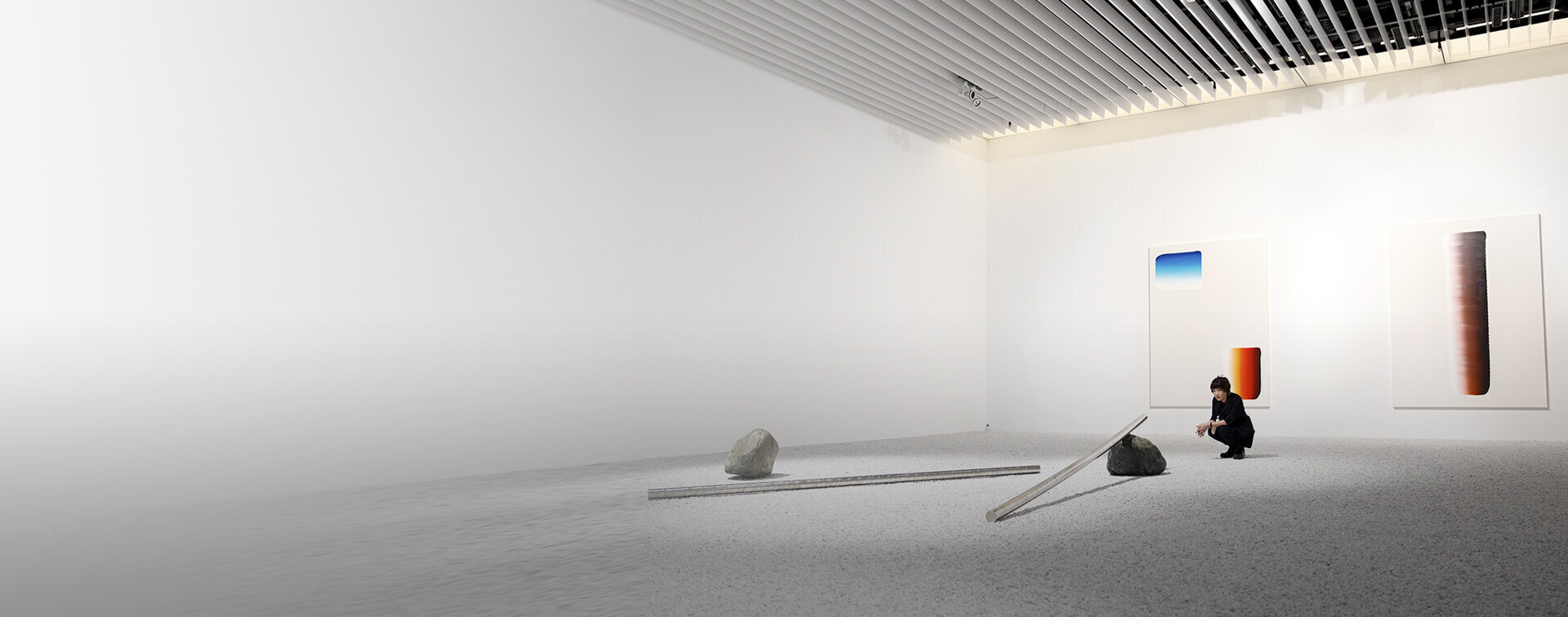
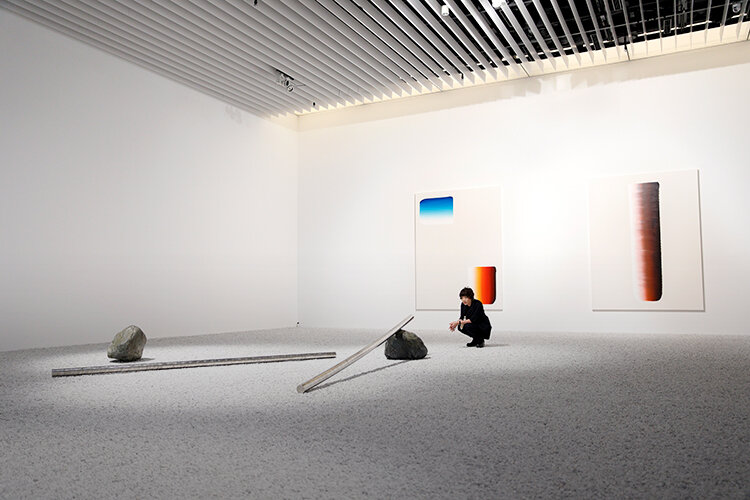
INTERVIEW
121
Mami KataokaDirector, Mori Art Museum
Balanced Coexistence – Connecting Local Communities Worldwide and Sharing Activities
Rediscovering the community through the “eyes of a beginner”
From the time the Mori Art Museum opened in 2003, Mami Kataoka served as its chief curator before becoming director in January 2020. As someone directly involved in the relationship between Roppongi and art, what does she think about the museum’s future and that of the community and art relationship? I went to ask, visiting her at the museum where the “STARS: Six Contemporary Artists from Japan to the World” exhibition had just started following the museum’s five-month closure due to COVID-19.
Not choosing between two things, but rather, a balanced coexistence
Since opening, the Mori Art Museum has focused on "contemporary" and "international" aspects. Regarding the international attribute in particular, the museum's inaugural director, David Elliot, was the first non-Japanese director in the history of Japanese museums. In planning its exhibitions, etc. the museum has also emphasized directing its work toward the international art community. As a result, it has come to be recognized as a museum possessing a strong international network. And, since its opening throughout today, it has attracted a large number of overseas visitors.
How should international/global perspectives, a strength of the Mori Art Museum, relate to regional and local perspectives that could be considered the exact opposite? In thinking about internationality, what I have become more aware of over the last five years is its relationship to regionality. I do not think that global and local are in directional conflict. Rather, I think we can try to find internationality through regional activities. I am sure there is a way for concepts and directionality that are thought to be opposite to exist together at the same time. As such, for the museum's future, I would like to consider a balanced coexistence between the two, rather than choosing between the two.
For the contemporary aspect as well, it is not only about looking at the "present," but also about things that emerge by looking at the "past." I would like to keep an eye on the present while properly considering our position through the long lens of history, the history of humankind, the history of the earth.
Specialization and popularity - why a star is a star
The STARS exhibition, which started in July, was originally planned to be held during the Tokyo Olympic and Paralympic Games. We considered what overseas visitors coming to Japan would want to see, as well as what we wanted to show them. The result was an exhibition connecting and showing the early and latest works of six top, globally recognized contemporary artists. These six artists have received high praise overseas, and people often ask, "Where in Japan can I see the works of these artists?" Despite this interest, the work or some artists their work cannot be permanently seen in Tokyo. Lee Ufan, for example, his work is permanently exhibited in Naoshima, Kagawa Prefecture. So, for works like those lined up for this STARS exhibition, I wanted to have them permanently exhibited somewhere in Tokyo, I wanted to create such an exhibition, and that is how the planning for this started.
I believe the "STARS: Six Contemporary Artists from Japan to the World" exhibition will greatly impact the character of the Mori Art Museum going forward. The reason being is that the exhibition is also related to the concept of coexistence between two things, "specialization" and "popularity," and I would like the museum to include both. While being open and accessible to people unfamiliar with contemporary art, I would like to hold exhibitions that also present new discoveries and evoke nods of understanding, even when viewed by experts or people familiar with art. So, what I thought was important this time was not making the stars look like stars, but to show how they became stars, to show that trajectory. With Japan as their starting point, from where and how did ordinary young people embark on their careers? I thought it would be interesting to tell that story. I think the path they took will make people who will become stars in the future discover their own potential.
STARS: Six Contemporary Artists from Japan to the World
An exhibition bringing together six artists who are globally acclaimed stars and attracting attention from around the world (Yayoi Kusama, Lee Ufan, Tatsuo Miyajima, Takashi Murakami, Yoshitomo Nara, and Hiroshi Sugimoto). Their journeys, from their earliest to latest works are traced. Scheduled to run until Sunday, January 3, 2021.
Views of the exhibition: STARS: Six Contemporary Artists from Japan to the World, Mori Art Museum, Tokyo, 2020
Photo: Kozo Takayama
Images courtesy of: Mori Art Museum
Another feature of the exhibition is the establishment of an archival corner. From the 1950s onward,how was Japanese contemporary art introduced overseas? How was it perceived? This display provides a summary. Globally, Japan's political and economic position is changing, and the way non-western art is perceived is also changing. By looking at that from a broader perspective, I think understanding for these six artists can also be deepened. I think those new to art can enjoy the exhibition by just looking at the works. However, many people are also enthusiastically looking at the archival displays, and that makes me happy.
Archival Displays
"Career Timelines" provides chronologies of major exhibitions, catalogs, exhibition photos and reviews, and other materials related to the six exhibiting artists. "Fifty Overseas Exhibitions of Japanese Contemporary Art" highlights 50 selected Japanese contemporary art exhibitions held overseas between the 1950s and today, providing an overview and exploring the history of their reception.

The value of appreciating art in person, an experience that supports the human spirit
Due to the impact of COVID-19, the Mori Art Museum closed at the end of February, and the STARS exhibition is the first themed exhibition to be held since the museum's reopening. I am glad this exhibition by six powerful artists is our first after five longs months of closure. Museums around the world took on the challenge of creating online programs due to the COVID-19 crisis. However, we were able to reopen as the limits of the online experience became apparent. And I believe the dynamism and vitality of the in-person "real experience" were more straightforwardly conveyed precisely because the exhibit featured works by these six potent artists.
There is a tendency to think of art as something that is only appreciated with the eyes; however, in reality, it is something experienced with the whole body, not just the sense of sight. For example, this is true of the "sound" one hears in Yoshitomo Nara's exhibition room and the scale of a work one can feel with their whole body. Sometimes the senses of smell and touch are involved; all five senses may play a role. The experience of using all five senses gives the human spirit great strength. Art is not a nonessential item, though separate from infrastructure necessities such as food, clothing, and shelter, it is necessary for maintaining the human spirit. As someone involved with a museum, I think the magnificence of the real, in-person experience should continue to be emphasized going forward. On the other hand, I am also once again feeling the possibilities presented by digital technology that is continually advancing. It is not about replicating the real experience through a digital medium but about activities that can effectively fuse the strengths of both.
For the STARS exhibition, text introducing each artist has been posted on the museum's website. The introductions are longer than usual. This is so that people can use them to learn more about the artist before they visit the museum and to review the information after their visit. Recently, many exhibition explanations have become long and cannot be easily read on the spot, so I think moving them online is a possible solution that could be used going forward. The same holds true for long video works. Additionally, after having a real, in-person experience, visitors can view gallery talks and other content online, further deepening their understanding of the work. By effectively coordinating with digital elements, I believe there are infinite possibilities for appreciating exhibitions in a manner that will not end with an in-person visit, allowing for expansion that will add more meaning.
Contemporary art is practice for how to live life
For an artistic experience, I believe a physical experience or an emotional experience that appeals to one's feelings and sentiment is very important. Secondly, I also believe that as knowledge, it is extremely important to learn about the history of the work, as can be done this time through the archival displays. You need both a physical experience and an intellectual experience; in other words, both an "experience" and a "story" are necessary. When those two elements are provided, art becomes a truly great force for living life.
It is frequently said that contemporary art is difficult and "hard to understand." However, I believe that non-understanding or uncertainty can provide the viewer an opportunity to practice and think about what direction to take. Among the many interpretations and ideas, which will you choose? To face that is also to face the question of "how to live life," which is a question imposed on us all.
In the times ahead, the stance of just doing what you are told will no longer work. Even within the corporate setting, if you just do things because "that is how they have been done to date" or simply because "my boss told me to," you won't be able to accomplish anything. You must think for yourself, always questioning and asking yourself, "Is that really true?" In that sense, by learning from a contemporary art experience and story, you will be forced to ask various questions. And I think figuring out the best direction to take when doing so can play an extremely important role in "training one's self to think for one's self."
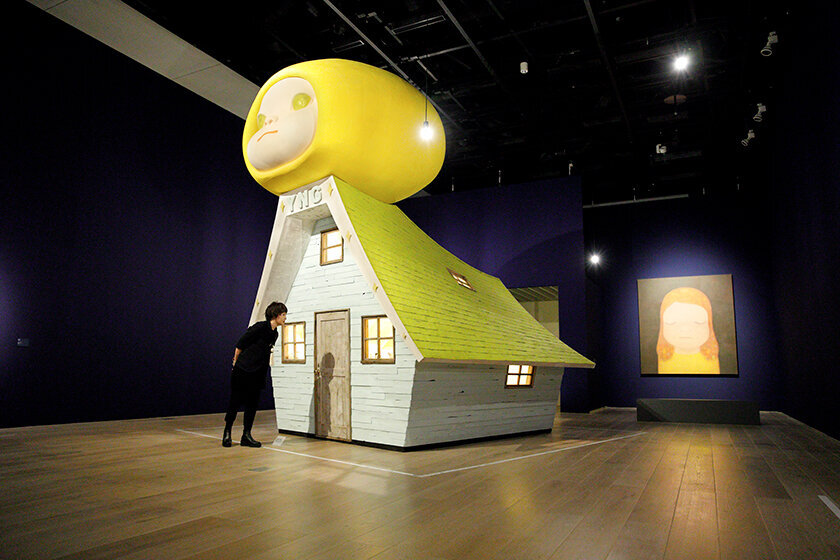
Thinking about what can be done next based on local modernism
Contemporary art has significantly changed its direction in the last 30 years or so. First, the state of contemporary art and its history, which was centered on the West, has expanded to various regions worldwide. A major tide of change is influencing politics and economics, but also art, and the people in each country and region are asking themselves about their own circumstances and conditions and how that can be weighed against global trends. How is it relative? Such a way of looking at things is needed, and it will become even more important in the future.
Take, for example, Takashi Murakami, an artist who has developed a clear strategy for challenging contemporary art that has been driven by the West. That is why he has been able to garner such a large degree of global recognition. While learning from that path, going forward, Japanese artists need to stand on the foundation of modernism developed in their respective regions and think about what they can do next.
While Japan is close to Europe and the United States in terms of social and economic modernization, geographically, it is located in the Asia-Pacific region. How should that ambiguity be leveraged? I think the type of cooperative relationship Japanese artists build with the "development of art in the Asia-Pacific region" will be a very important issue going forward.
If anything, it is said that Japanese artists have weak social and political perspectives. Of course, those perspectives are not the only ones that apply to contemporary art. Personally, I hope more people will look for the next step after first broadly looking at the world and understanding Japan's history and position in it.
The world is a composite of local communities
Next year, ten years will have passed since the Great East Japan Earthquake struck on March 11, 2011. After that earthquake, awareness of "how can art contribute to the local community" has rapidly increased. At art festivals held in local cities all over Japan, many works with roots in the local area are displayed, and I feel that awareness is starting to spread widely. However, while it is spreading, it is also difficult to see how it is linked to the world at large. Is the work directed toward the world? Or is it directed toward the local community? I don't think it must be a choice between one or the other. We must think more about how to properly connect to the world while gazing firmly at the local community.
The relationship between a local community and the world is not one wherein the local community rests below an amazing world that sits above it. Rather, the world is a composite of a diverse range of local places. As such, it is entirely possible for local communities to link internationally, and many artists are trying very interesting things in different parts of the world. I would like to increase opportunities for inviting such people to come to Roppongi. For example, how could activities being carried out in a village in Mexico be utilized when put in the context of the neighborhood of Roppongi in the city of Tokyo, Japan? Or, from the perspective of Roppongi, what can be done by replacing what is being carried out locally in Mexico with our own local context? I think there is a lot that can be mutually learned from exchanges such as that, and I think it opens up a view to the future.

Discovering and sharing the allure of Roppongi through the "eyes of a beginner"
When looking at Roppongi as a stage for art, the "Roppongi Art Night" has played a large role. By continuing to hold it for ten years, it can be said that it has become an established event for both art professionals and visitors interested in art. However, the moment something becomes established, it becomes standardized, and I am wondering if we are entering such a period. Such standardization is a concern. If you continue something for many years, you can end up inheriting a "template" or "model," and the question of why you are doing it becomes lost. Honestly, we should ask that question every time we do something. Due to the COVID-19 situation this year, I don't think it can be held as usual. So, I would like to use this as another opportunity to question myself again about the future.
Roppongi Art Night
A festival of art in Roppongi that has been held continuously since 2009. The neighborhood itself becomes a museum featuring exhibitions and programs for one night. The event proposes a new lifestyle in which people "can enjoy art in their lives." Mami Kataoka will serve as the executive chairperson for 2020 (the 2020 event has been postponed until 2021 due to the impact of COVID-19).
This is my personal opinion, but what I would like to do in the future for the event is to extend the period and broaden the area a little more. The number of exhibitions is increasing, so it is difficult to go around and see them all in one night. For example, if the event period could be extended to one month, and then on the final night only hold an all-night festival, I would like to try something like that.
I think it's OK to put a little more effort into rediscovering the district of Roppongi through Art Night.As I mentioned earlier, it would be good to connect people who are active in their local communities around the world with Roppongi locals and have them share content from Roppongi. When the SUN SHOWER: Contemporary Art from Southeast Asia exhibition was held in 2017 as a collaborative plan with the Roppongi Art Night, participating artist Navin Rawanchaikul made a film. Although he is Thai, he worked very well with the local people, and I think discovering and sharing the allure of Roppongi through the eyes of such outsiders can still be done.
SUNSHOWER: Contemporary Art from Southeast Asia 1980s to Now Exhibition
An exhibition jointly hosted by the Mori Art Museum and the National Art Center, Tokyo in 2017. Focusing on Southeast Asia, the exhibition introduced contemporary art from the 1980s onward. Using both museums, a total of 86 Southeast Asian artists/groups participated and conveyed the state of the Southeast Asia region, which is undergoing significant change, and provided historical background.
Navin Rawanchaikul: OK Festival - Roppongi Story 2017
Thai artist Navin Rawanchaikul held a "festival" at Roppongi Nishi(West) Park. A short documentary "OK Festival - Roppongi Story" depicting the daily lives of Roppongi people was screened, and dance performances and a workshop were held.
Navin Rawanchaikul OK Festival - Roppongi Story 2017
Acrylic paint on canvas 170 x 450cm.
The eyes of outsiders are important. The same is true of Japanese contemporary art and Japanese culture. Like how Bruno Taut introduced the Katsura Imperial Villa, there are places whose charms have been rediscovered by various people looking in from the outside. For the district of Roppongi as well, the more people live there, the more they get used to it. So, I think it is necessary to repeatedly see what is special about the area through the "eyes of a beginner."
A multilayered art stage where the neighborhood serves as a stage as well, both in the real world and the digital one
In the sense of rediscovering the charm of a neighborhood, there have been cases where the neighborhood itself serves as a stage for art. In 1986, in the city of Ghent, Belgium, the exhibition Chambres d'Amis was held. Chambres d'Amis means "guest rooms," and for the exhibit, artists went to more than fifty ordinary homes throughout the city and turned the houses themselves into exhibition halls. It was a ground-breaking trial in which the art viewers went around and visited these ordinary city homes. Jan Hoet, who later became the director of the Museum of Contemporary Art in Ghent, curated the event. In the history of art exhibitions, this event is known for having been a very important project.
As one would expect, in modern Roppongi, it would be difficult for people to allow strangers to come into their homes. However, it is interesting that art could be found in buildings not often visited by the public or in the gardens of homes, rather than in famous museums or well-known public places. By visiting art scattered around the city in this way, you could also experience the history of Roppongi and meet people who have lived in the neighborhood for a long time. But this is just a personal dream; it doesn't take into account various safety and feasibility considerations....
For cities that do not have museums of contemporary art, using the city itself to exhibit art is a technique that has been practiced all around the world. Once a contemporary art museum is established, then all art activities end up being concentrated in the museum. However, it isn't easy to judge whether that is a good outcome or not. Art is not something that becomes complete inside a building alone. That is something that we at the Mori Art Museum also think about. I hope that the concept of the Mori Art Museum will permeate throughout the city and that the facility will not simply be viewed as hardware. If everyone thinks of the space of the actual museum, digital space, and the neighborhood itself as a stage for art, I think activities will become multilayered, and possibilities will expand.
Editor's thoughs
When I asked her about the highlights of the STARS exhibition, Ms. Kataoka spoke particularly enthusiastically about the archival displays. She noted that studying the history of exhibitions from the 1950s onward was a way to further enjoy art by deepening one's understanding. During the interview, she also brought out catalogs of old exhibitions that she had personally collected and showed them to me. While giving off the impression of someone in possession of strong leadership skills, she also offered a look at someone who enjoys researching contemporary art.(text_tami okano)
RANKING
ALL
CATEGORY




